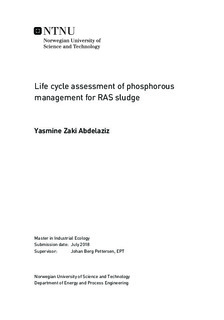| dc.description.abstract | Phosphorous (P) is an essential nutrient and its recovery from aqua-
culture sludge is the main core of this study. As the global reserves of
phosphate rock are likely to be depleted in the next 50-100 years, it is
crucial to investigate a more sustainable P management. The present
research first introduces the situation of aquaculture in the Norwe-
gian context and describes the main characteristics of Recirculating
Aquaculture Systems (RAS). Then, the role of Life Cycle Assess-
ment (LCA) in assessing the environmental impacts of aquaculture
and sewage sludge treatment is examined. Follows the design of a
hypothetical RAS for harvesting Atlantic salmon in its whole life pro-
duction cycle. Different technologies for the treatment of fish-based
sludge and phosphorous recovery are modelled in SimaPro, namely
anaerobic digestion (AD), thermal treatment (incineration) and en-
hanced biological phosphorous removal (EBPR) with struvite crystal-
lization. The different scenarios are considered in a local and in a
centralized alternative. The functional unit (FU) chosen is 1t of raw
sludge, which is treated and produces phosphorous (P)-rich fertilizer,
or biogas. The different scenarios were compared with the reference
scenario, consisting in land spreading of sludge without prior treat-
ment or conditioning. The anaerobic digestion of fish-based sludge
in the local scenario, to produce liquid fertilizer from digestate, and
heat and electricity from biogas was proved to cause the lowest envi-
ronmental impacts, especially in terms of human toxicity. The highest
environmental impacts belong to the reference scenarios, both in the
local and centralized option. The option of thermal treatment showed
lower values compared to the EBPR method, due to the reuse of the
heat produced in the incineration plant. | |

